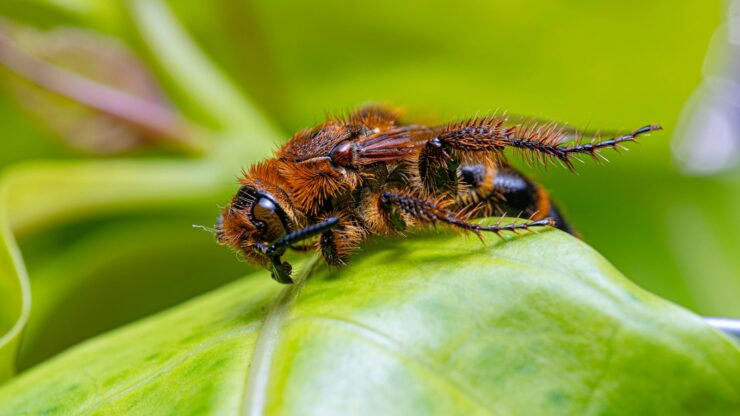The invasion of the Asian hornet (Vespa velutina) is, in recent years, a real worry for all beekeepers throughout Europe and elsewhere. Whereas European hornets, Vespa crabro, are native, the invasion of their Asian relatives does bring forward several challenges to apiculture. Both species are interesting for the understanding of their behavior and how they relate differently to beekeeping for the perspective of management and mitigation.
Introduction to the Species
Asian Hornets
The Asian hornet, also known as the yellow-legged hornet, is native to Southeast Asia but has spread into Europe and beyond. This insect is differentiated by its dark brown body and prominent yellow-orange band located at the end of its abdomen. Asian hornets are much smaller compared to their European cousins but notable for their aggressiveness and highly effective way of predation.
European Hornets
The European hornet is native to Europe and is generally larger compared to the Asian hornet. It has a mainly yellow and black body, with a stronger build. European hornets are generally much less aggressive toward humans and are considered valuable pollinators; however, they are predators and are thus considered a problem by beekeepers.
European Hornets
🆚
Asian Hornets


Behavioral and Ecological Differences
Aggressiveness and Predation
Asian Hornets: Most of the time, Asian hornets hunt aggressively, preying on most insect species, including honeybees. This highly impacts the entire population of a hive because one hornet may be able to kill many bees within a very short period of time. During the attack on the beehives, they proceed in an organized way, killing the worker bees and taking them away to feed their larvae.
European Hornets: Just like Asian hornets, European hornets attack honeybees; however, this is generally at much reduced intensities. Typically, they are less aggressive, being hunting predators that take advantage of any opportunity that might arise. Their predation on the bees is sparser and usually does not escalate to raiding beehives.
Nest Construction
Asian Hornets: Asian hornets make their nest in sheltered, high places and are usually found nestling among trees and bushes. The nests are spherical in shape and of a paper-like material manufactured from chewed wood fibers mixed with saliva. These nests may grow quite big, more than a meter in diameter, and hold thousands of hornets.
European Hornets: European hornets also create large nests, with a paper-like appearance but are more likely to be situated in cavities such as wall voids, attics, or tree hollows. European hornet nests are usually less aggressive in respect of size when compared to Asian hornets. Though the nests of European hornets may also be considerable, they are commonly more protected from human interference.

ASIAN HORNET NEST

EUROPEAN HORNET NEST
Impact on Beekeeping
Honeybee Predation
Asian Hornets: The infestation of Asian hornets in any area has resulted in a drastic decline in the population of honeybees. Because of their effectiveness while hunting and the fact that they can disrupt hive operations, they have proved to be really dangerous to beekeepers. When there is a loss of worker bees, the colony weakens, honey production decreases, and eventually leads to the collapse of the hive.
European Hornets: These hornets also pose a grave threat to honeybees, but on a much less dramatic scale. They do not hunt en masse or in organized raids, as a rule, and therefore do much less damage overall to the bee colonies. They do occasional predation that a beekeeper can notice but is less disruptive compared to the effects of Asian hornets.
Hive Defense Strategies
Asian Hornets: Honeybees have significant challenges defending against Asian hornets. The strategy of Asian hornets is to remove bees from the hive, compromising the foraging ability and the ability of maintaining hive temperature of the colony. Many beekeepers employ physical barriers and traps that are intended to catch Asian hornets with a hope to reduce the impact on bee colonies. However, most of these measures require continuous maintenance and vigilance.
European Hornets: Honeybees are more adapted to European hornets. Attacks on hives by European hornets are less likely to be en masse than those of the Asian giant hornet and their predation normally does not involve large groups of hornets. Most of the defensive measures similar to entrance reducers and traps, that beekeepers can adapt against Asian giant hornets may also be applied against losses to European hornets.
Managements and Control
Asian Hornets: A holistic approach ought to be adopted for managing the Asian hornets. In other words, preventing their spread and limiting their impacts depends on monitoring and early detection. Beekeepers should set traps and regularly check hornet activity in their hives. In addition, community-wide awareness and cooperative efforts with the local government will help in controlling their populations and reducing numbers in an infested area.
European Hornets: In most instances, management for European hornets is less complicated. Beekeepers may use ordinary methods of pest control in their operations and observe the hives for any activities from the hornet species. European hornets are mostly just a nuisance, and their damage is less heavy; this is commonly managed with precautions that prevent them from building up their numbers.
Asian Hornets: The impact of the Asian hornet is not limited to the impact on beekeeping. Their predation on honeybees can have disruptions in local ecology since they play an important role in pollination. Decline in bees will affect plants reproduction and overall biodiversity. In addition, they are known for displacing other insects, both native and non-native ones, through competition, thereby having a contribution to the broader ecological imbalance.
European Hornets: Being predators generally does not disrupt the local ecosystem much. Being pollinators themselves, and their lesser pressure on the populations of honeybees, means they do not cause an ecological disruption on the same scale as Asian hornets.
Economic Impact
Asian Hornets: The economic impact associated with beekeeping due to Asian hornets is very high. This includes loss in colonies of honeybees that will reduce honey production, increase management expenses of the hive, and thus possibly result in economic losses for beekeepers. Further, continuous monitoring and control will also create an economic burden.
European Hornet: In general, the economic impact of European hornets is considered to be low in comparison with Asian hornets. They have much less aggressive predatory behavior, and thus, the overall impact of their actions concerning bee colonies is much smaller. That means beekeepers do not face many economic losses. Still, their presence would require attention and management to stop any economic consequence that might arise.
Conclusion
While the Asian hornet and European hornets are both formidable to beekeepers, they can be compared for some striking behavioral differences, divergent impacts on beekeeping, and wider ecological ramifications. Both species are challenging for beekeepers; however, because of the aggressiveness and potential severity of damages to honey bee colonies by the Asian hornet, its urgency is higher. Management of Asian hornets can effectively combine monitoring with early detection and public awareness, while European hornets require much less intensive control.
For the implication of targeted strategies toward honeybees and healthy beekeeping, knowledge about such differences becomes important. This can help beekeepers have a better understanding of the most practicable steps they might take to negotiate these challenges more ably with each of these hornet species.





















